
The B2B customer journey highlights all the touchpoints a customer has with a B2B company. From discovery to purchase and beyond, it’s important to have a bird’s eye view of the entire customer experience.
This is where a B2B customer journey map comes in. It helps businesses better understand the path a customer takes during their decision-making process and how they ultimately become customers.
What is a customer journey map?
A B2B customer journey map visually represents each customer journey stage from start to finish. It covers the moment the customer realizes they have a problem to the moment the customer discovers your business as the solution.
Above is an example of a simple customer journey map, where we see seven total stages: awareness, research, decision-making, onboarding, usage, support, and renewal.
This helps us remember that the customer journey doesn’t end with a purchase. Other touchpoints include the customer using your product or service, potential customer support requests, and the hope of a renewal or retained customer.
How to create a B2B customer journey map
Creating a map of the buying journey helps you identify each place where a potential customer might come in contact with your business.
This allows you to better prepare your sales, marketing, support, and other customer-facing teams so they can generate more sales and retain more customers.
We’ve created a 7-step journey mapping process to help you get started:
1. Define your buyer personas
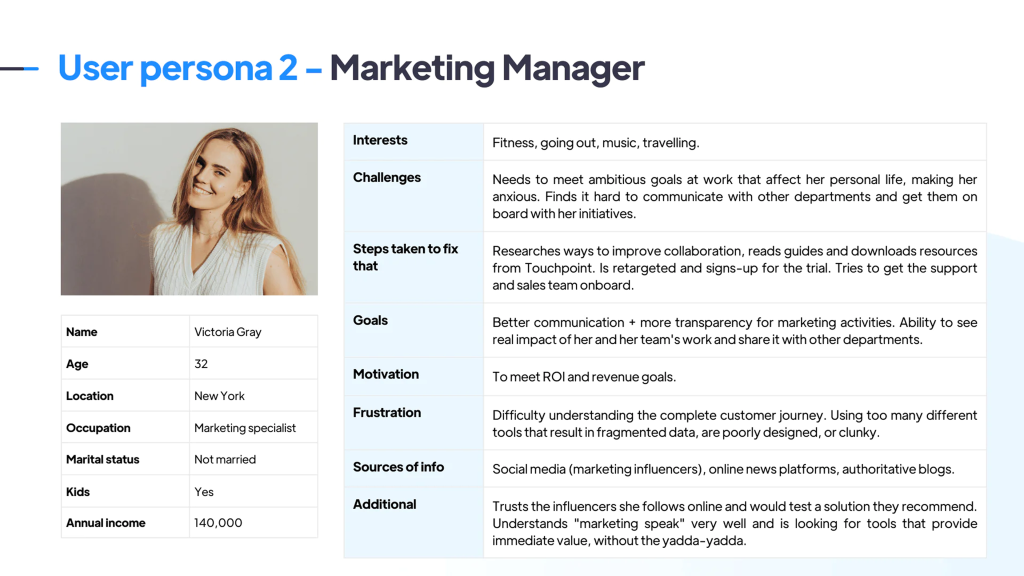
A buyer persona is a fictional representation of each of your customer segments. It helps sales and marketing teams better identify your target audience to reach more potential new customers.
These are typically drawn up into a visual customer profile, like in the example above.
Create a separate buyer persona for each particular segment of your audience. For example, you might cater to both a company’s sales and support departments. However, those buyer journeys will differ, so you must create separate personas.
When building out your buyer persona(s), you’ll need the following customer data:
- Demographics: Age, location, gender identity, income
- Career information: Job title, company, industry, decision maker
- Interests: Hobbies, media consumption, favorite brands
- Buying behaviors
- Pain points/challenges
- Goals/objectives
You can interview existing customers to help gather some of this data or use what you already know about your customers to build out each buyer persona.
2. Identify customer touchpoints
The next step is to identify all customer journey touchpoints — where do your customers come into contact with your business throughout the buying process?
There are five main stages of the customer journey that these touchpoints will fall into:
| Awareness | Consideration | Conversion | Service | Advocacy |
| Blog content Social media content Online ads Search results Consideration | Case studies Testimonials Review sites Video tutorials Product demos Product or integration pages | Website FAQs Pricing page Email newsletter Sales reps Physical stores | Self-service help centers Support agents Chatbots Live chat Email support Text messaging | Sales rep conversations Upselling or cross-selling Transactional emails Renewal pages |
Pinpoint the touchpoints your business offers so you can include them in the customer journey map.
3. Conduct customer research
Customer research is crucial for mapping the customer journey. You can only map what you know, so you must conduct proper research to gather accurate data.
There are a few different ways to do this:
- Conduct interviews and speak to customers directly
- Hold focus groups to gather customer sentiment
- Work with a market research firm to run in-depth qualitative surveys
- Send out quick customer surveys via email
Depending on your budget and the amount of research you need, each of these outlets can be an excellent way for B2B businesses to conduct customer research and ensure they have the exact customer journey straight from the horse’s mouth.
4. Map out your journey stages
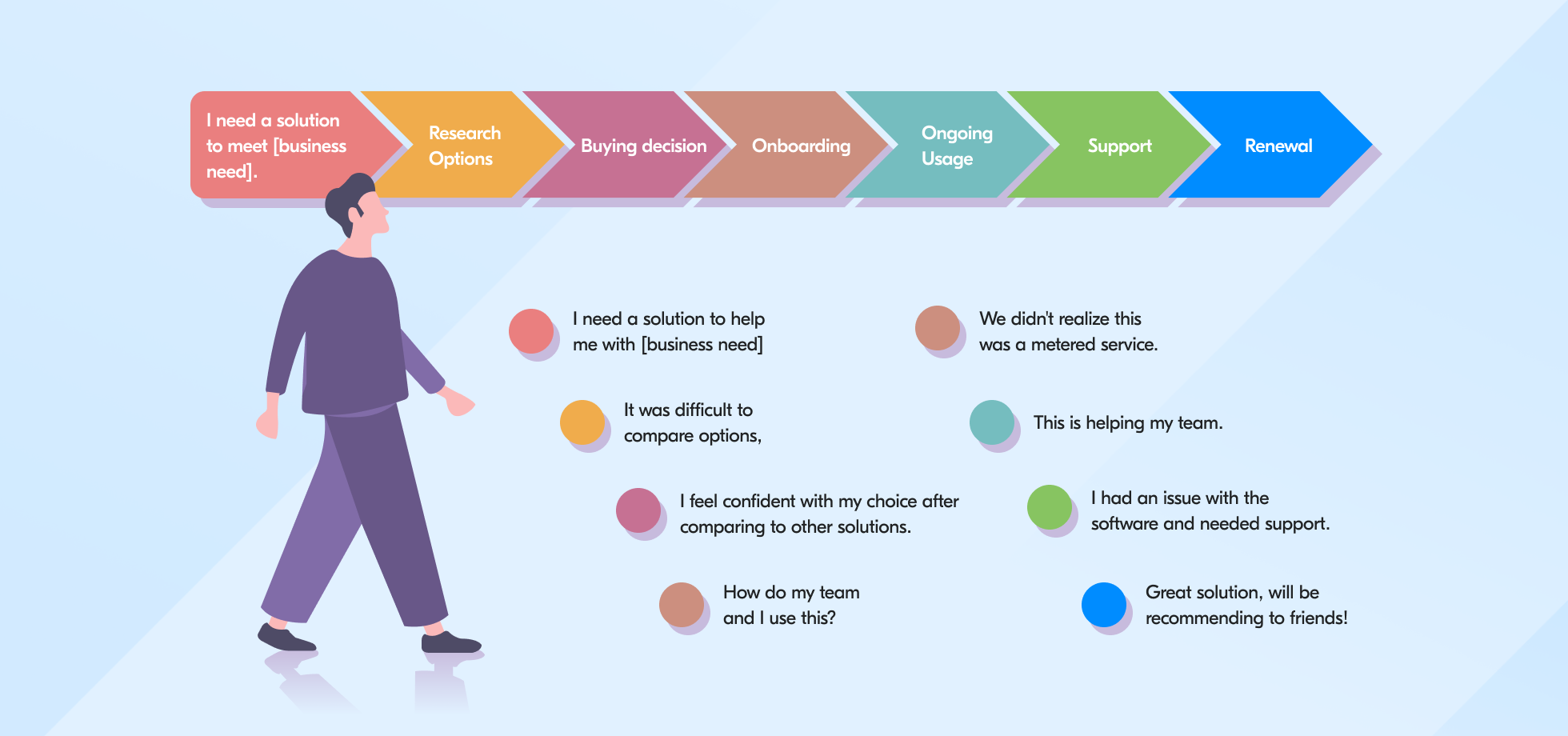
We’ve covered the five most popular customer journey stages, but that doesn’t mean your business has to be married to those stages.
You might decide to stick with four stages: awareness, consideration, decision, and retention. Or, you might have six stages in your customer journey: discovery, evaluation, purchase, usage, bond, and advocacy.
For the most part, these stages break down like this:
- Awareness: Buyers are just starting to become aware of your business. They may have seen a social media ad or discovered a blog post in search results. Your marketing team typically has the most significant hand in this stage.
- Consideration: Customers start considering your product or service as the solution to their pain point(s). They read testimonials and case studies, check your product or sales pages, and watch videos to learn more. Your marketing and sales teams work together on consideration touchpoints.
- Conversion/Decision: The customer decides which product or service they’re going with, making the purchase or signing up for the service. This stage also involves product delivery (if applicable). Your sales and customer success teams work together to close deals and onboard new customers.
- Service/Support: Your customers might seek support to help them get the most out of your product or service. Your customer service team will handle support issues easily and get your customers back on track.
- Retention/Advocacy: Here, your customers decide whether to remain loyal or find a new solution. They may sign up for a more extended subscription plan or renew their contract. Eventually, they may also become brand advocates, referring others to your business.
You can easily align your customer journey with your sales funnel so that each stage of the funnel and customer journey go hand-in-hand.
5. Analyze customer pain points and behavior
Are there any bottlenecks in the customer journey that are causing difficulties or pain points? You should be able to identify these as you map out your customer journey. If there are any areas where your touchpoints aren’t aligned or a team member isn’t properly monitoring the channel, it can cause disruptions.
Consider creating an omnichannel strategy that enables all channels to work together and makes a seamless customer journey.
By incorporating the right tech stack (and the right CRM), notes about each customer touchpoint can follow them through the journey, working to eliminate pain points throughout the process.
6. Develop an action plan
At this point, you should have a grasp on your business’s overall customer journey—from discovery to purchase to retention and (fingers crossed) advocacy. Now, it’s time to put together an action plan for building out the map, ensuring that all touchpoints are covered, and making any necessary improvements.
First, create stakeholders for each touchpoint to ensure no customer is left behind. This should remove potential bottlenecks and ensure someone is always available.
Next, look into any improvements you can make throughout the customer journey.
Are there any touchpoints you can add? Chatbots or live chat options can improve customer service. Cross-selling or upselling can improve customer retention. Video chat for both sales and customer support can build a more personalized customer experience.
Look back at the surveys and customer research you conducted. Did customers mention any potential issues? Start by fixing known issues that your customers have told you about first. Then, move on to any other improvements you might want to make.
7. Monitor and improve
The last step is to monitor and improve your customer journey continually. Continue to gather feedback on the customer journey from new and existing customers to see if there are any other changes you need to make. Monitor your analytics to see if there are areas where customers consistently fall out of the sales funnel.
A few customer success metrics to keep track of include:
- Net Promoter Score (NPS)
- Customer satisfaction (CSAT)
- First contact resolution (FCR) rate
- Customer retention rate
- Customer lifetime value (CLV)
- Conversion rate
Use the formulas to track them or monitor your most important KPIs using an analytics tool. Customer journey mapping tools and other tools that can help you map and monitor include:
- Textmagic: Allow your marketing, sales, and support teams to connect with customers every step of the way.
- Hotjar: Monitor how customers use your website to help build and adapt your customer journey.
- Google Analytics: Track your website visitors, demographics, traffic sources, and more.
- Heap: Gather customer experience data to inform your journey map.
Keeping an eye on your customer journey will help you discover if anything changes. Your map and overall customer journey strategy should be fluid, with the ability to adjust or change based on new data you might get from your customers.
B2B customer journey map templates
We won’t let you craft your customer journey map by yourself. Here are four B2B journey map examples you can use as a foundation for your own.
1. Customer touchpoint map
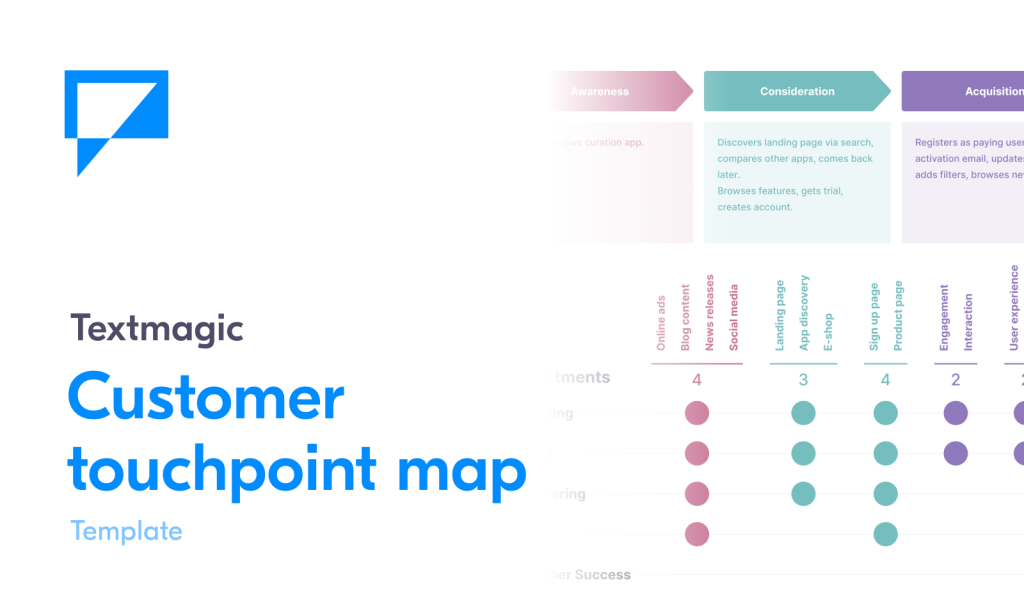
Use this B2B touchpoint map to highlight the main stages in the customer journey and identify which team is responsible for each step.
The template provides a solid foundation for cross-functional teams, helping them visualize their responsibilities and making it easier to delegate tasks or collaborate.
Want to grab this template? Here’s what you need to do:
- Click on button below to open the template.
- Follow the guidelines in the “Form” page to duplicate the template.
- Fill out your information and customize every step with a few clicks.
Fill out and customize every element to create your own customer touchpoint map, which looks something like this:
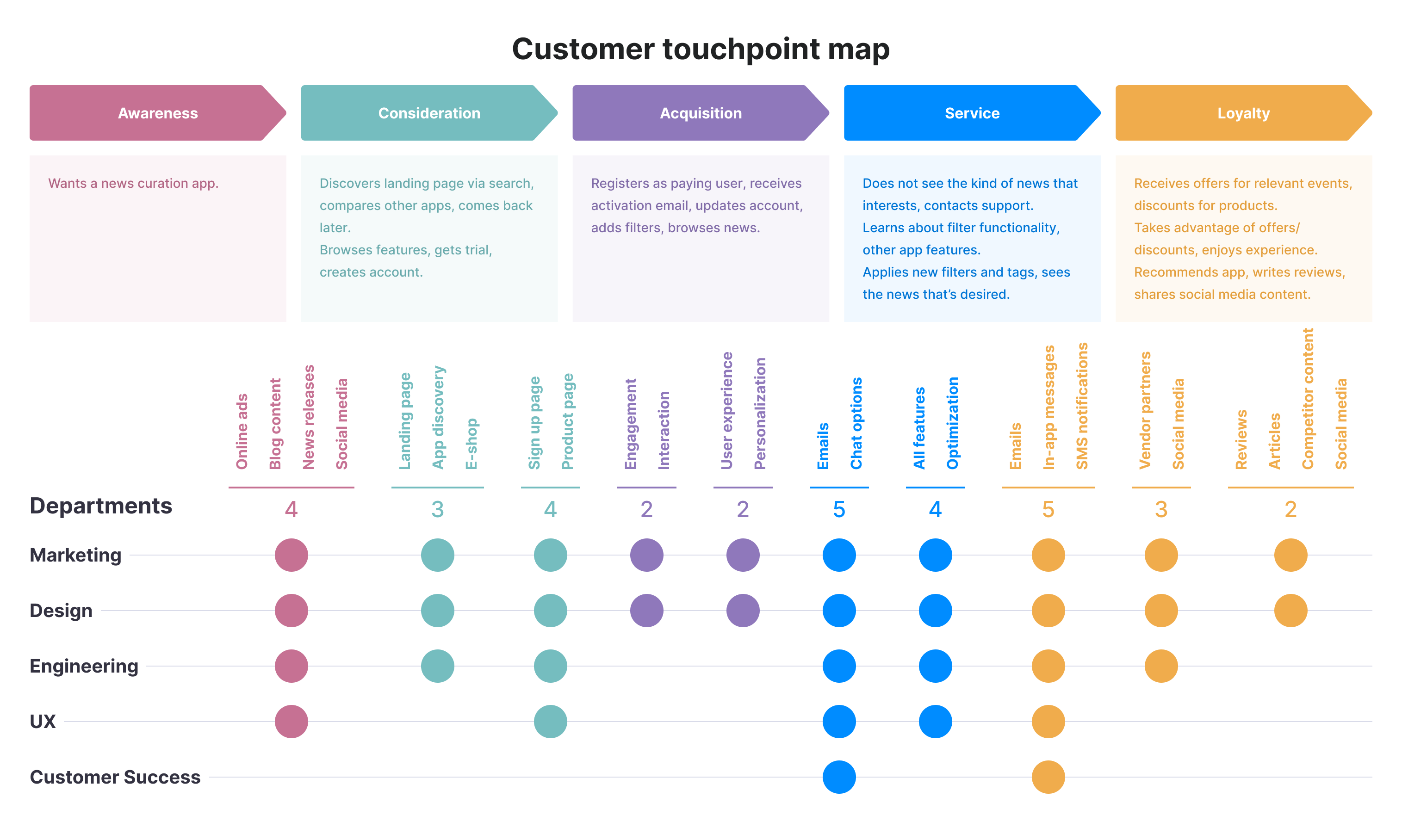
2. Ultimate B2B customer journey map
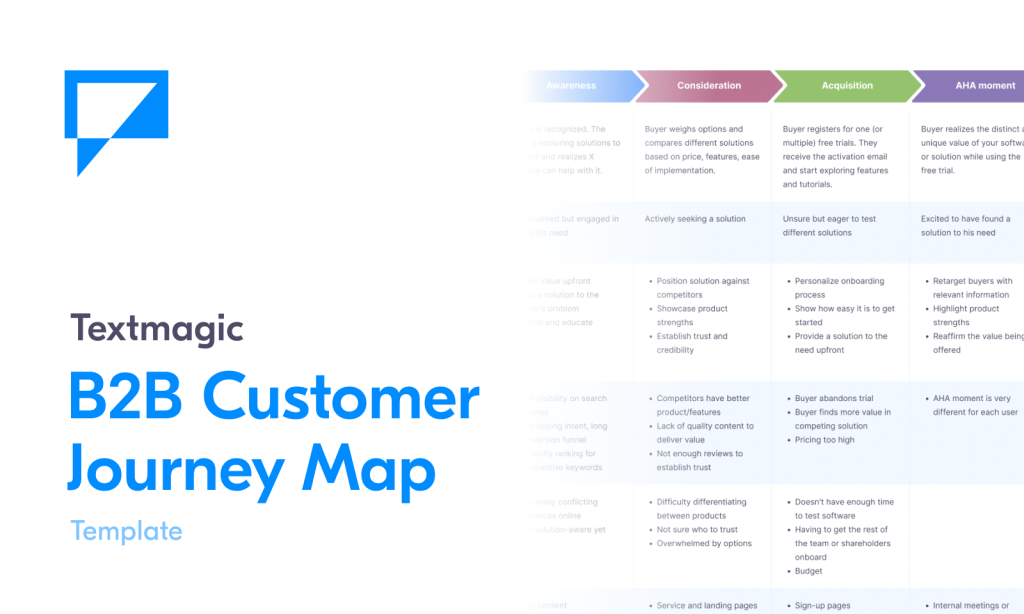
This B2B customer journey map template is a bit more complex. Its purpose is to detail every step of the user journey from awareness to loyalty and help you uncover opportunities to improve the customer experience.
Using our Figma template, you can map out the cognitive state, emotions, opportunities, pain points, and metrics that are relevant to each step in the user journey. Of course, you can also add or remove elements according to your particular use case.
Want to grab the template? Here’s what you need to do:
- Click on the button below to open the template.
- Follow the guidelines on the “Form” page to duplicate the template.
- Fill out your information and customize every step with a few clicks.
Depending on the amount of columns and rows that you add, the final customer journey map will end up looking something like this:
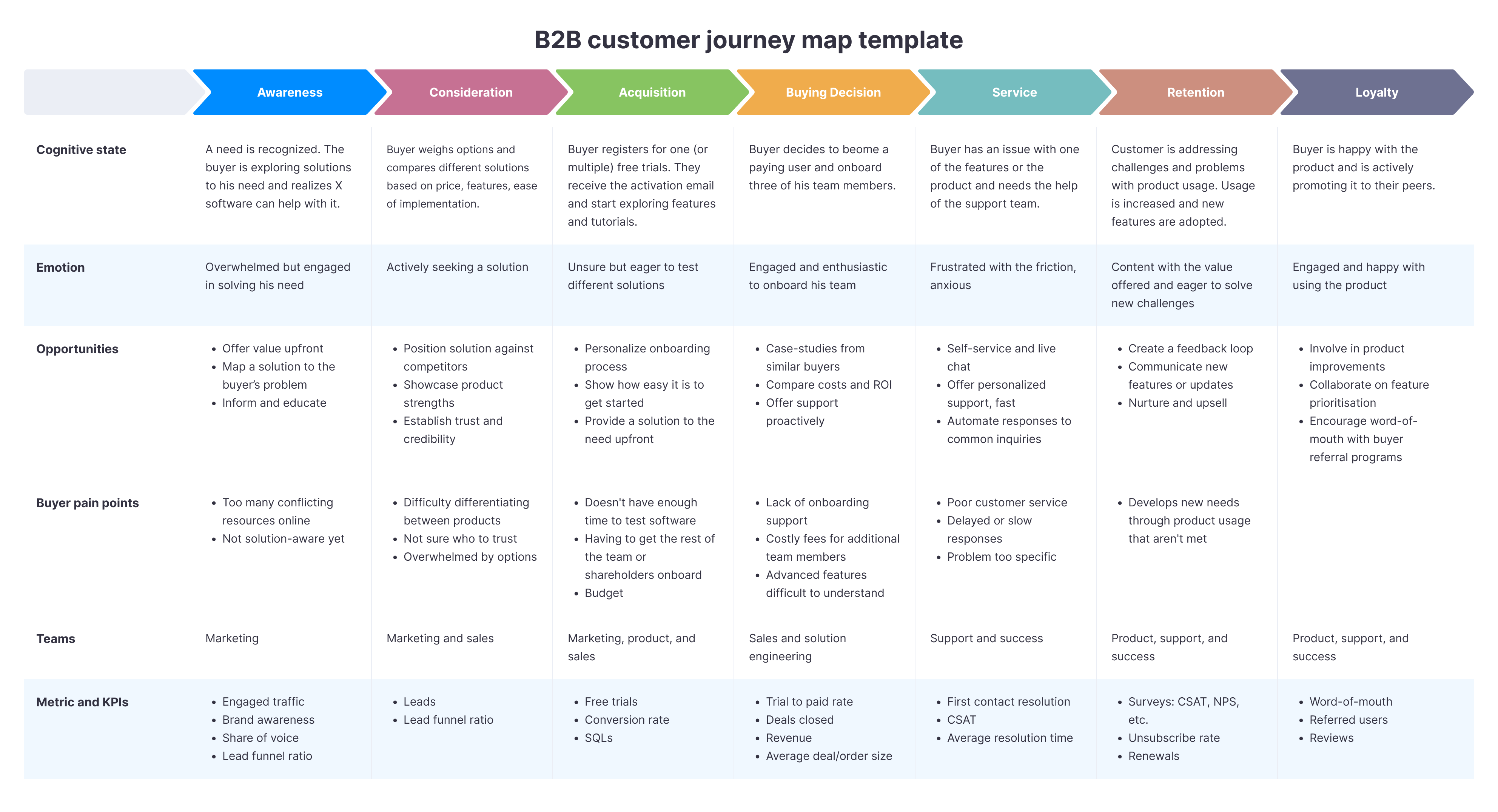
3. Simple B2B customer journey map
Was the previous template too complicated? Keep it simple with a customer journey map like the one above.
Focus on the most important stages of the purchasing process and list each potential resource you could use to convert your users.
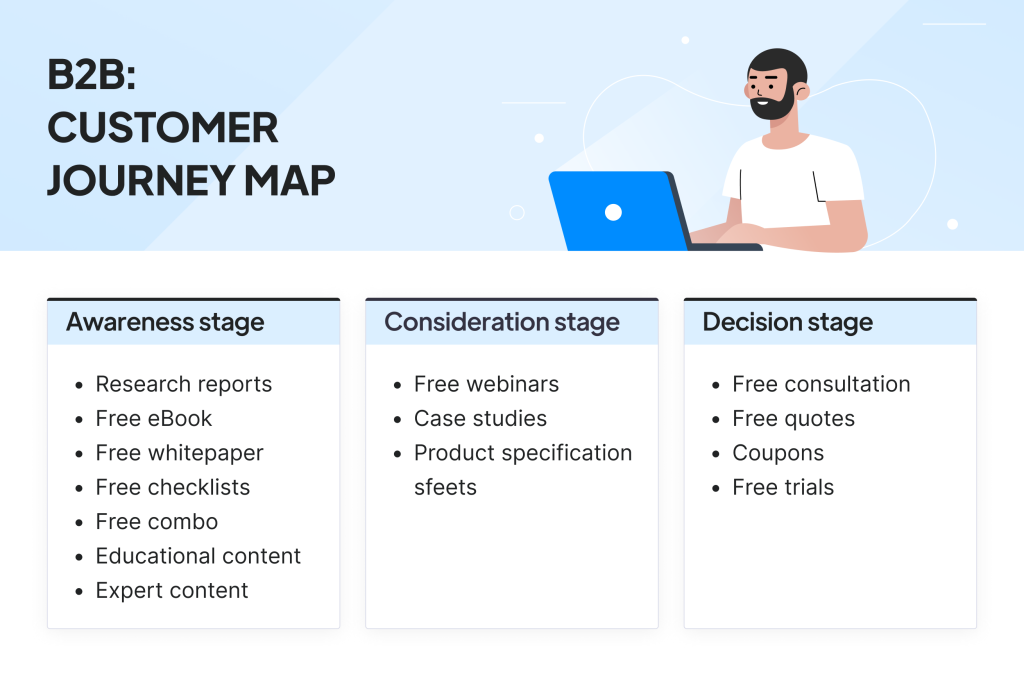
4. Nonlinear B2B customer journey map
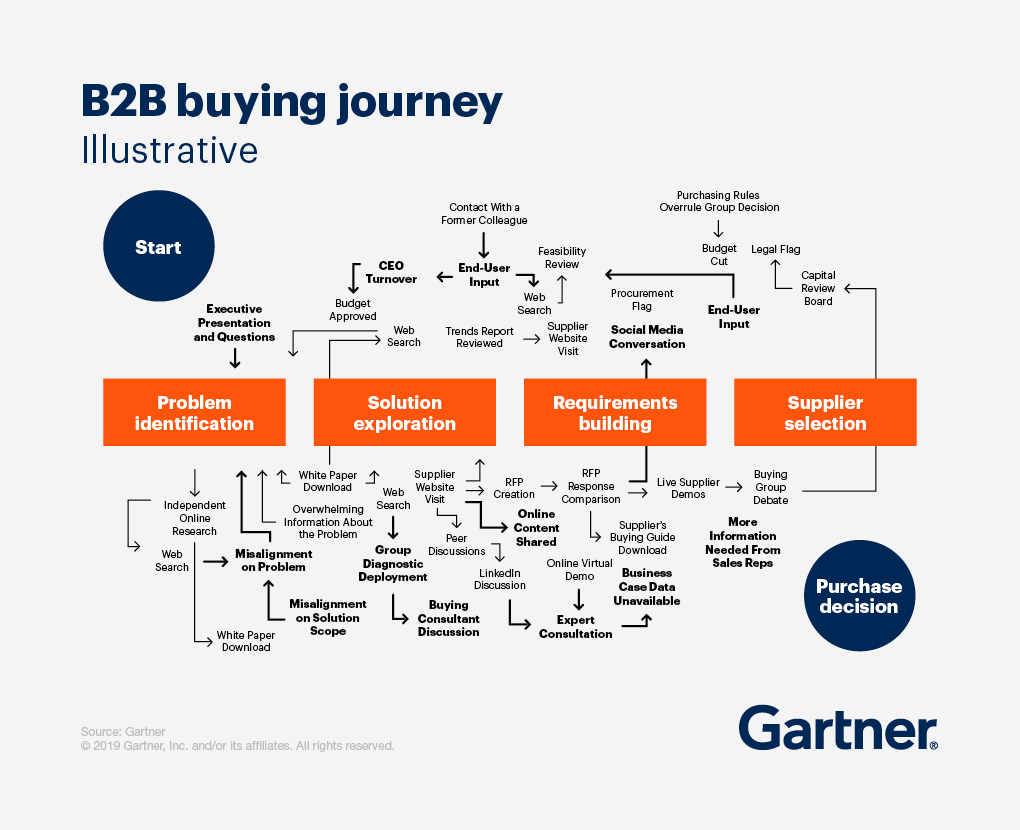
Of course, the customer journey isn’t linear. The templates above simply provide some clarity over the main steps. You might also like this B2B buyer journey diagram published by Gartner, which shows B2B buyers looping around different stages multiple times before making the purchase decision.
Use a customer journey map template like this to depict a nonlinear customer journey that your B2B buyers might be taking, from contacting your brand to reading case studies to checking out your social media content.
Create your own B2B customer journey map
Map out your B2B customer journey so you can connect with your audience at every touchpoint. Improve the user experience and improve customer retention in one fell swoop.
Frequently Asked Questions (FAQs)
The typical B2B customer journey includes several stages: awareness, consideration, decision, onboarding, retention, and advocacy. Each stage reflects how a business identifies a need, evaluates solutions, makes a purchase, and builds a long-term partnership.
The four most common types of B2B customers are producers, resellers, governments, and institutions.
The B2B cycle refers to the end-to-end sales process, starting with lead generation and moving through qualification, nurturing, conversion, and ongoing account management. It’s usually longer and more relationship-driven than B2C.
The five stages include initial contact, assessment, solution development, implementation & onboarding, and ongoing support and optimization. Each step strengthens trust and aligns the offering with the customer’s evolving needs.
Typical stages include: lead, marketing-qualified lead (MQL), sales-qualified lead (SQL), opportunity, closed-won (customer), and post-sale engagement or upsell. These stages help structure the sales process and forecast revenue.
Textmagic can be used at every stage: sending SMS and email follow-ups to leads, onboarding messages to new clients, and check-ins or reminders to boost retention. It’s a powerful tool for keeping communication personal, timely, and scalable.
Related articles
Successfully outsource customer service using 8 tips we tested ourselves
Poor customer service impairs user experience and un...
8 Easy ways to send texts from a computer (no phone needed)
Do you know that moment when you copy a message on y...
5 Ways to get the most out of your Textmagic trial
Not sure if business texting is right for you? Sign ...
Communication breakdown: What it is and how to avoid it
Discover practical strategies to prevent and swiftly...
60+ SMS and email statistics: Why using both channels works better
SMS gets opened by 82% of recipients within minutes....




